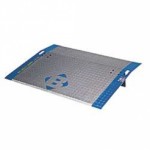Aluminum dock plates are the logical solution to loading and unloading trucks and trailers. While you may have seen them being used before, you may not be aware of all the benefits that an aluminum dock plate can have. These plates are similar in design to dock boards, and are actually often mistaken for the steel boards. There are differences, however. For lightweight unloading, most find that aluminum dock plates are the cost efficient and more practical choice with many benefits.
Aluminum dock plates are lightweight ramps that can bridge the gap between a loading dock and the back of a truck or semi-trailer. Each aluminum dock plate comes with steel legs that have been bolted on. This helps to keep the plate in place as a worker goes up and down without fears of the dock plate slipping out. Dock plates are built with two hand holes that help make moving and setting up even easier. Since aluminum dock plates are so lightweight, thin and easy to carry, one person can set it up without having to take another worker away from their duties.
Beveled edges on aluminum dock plates help to guarantee a smooth exit and entrance and helps to keep the plate in place. The plate is made from a diamond deck aluminum. This style of lightweight aluminum serves more than just one purpose. For one, the pattern helps to stop water, snow, oil or other debris from gathering and creating obstacles as you try to remove a shipment from the back of a truck trailer or load one on quickly. The diamond pattern also provides far more traction than a flat sheet of aluminum would. This safety measure prevents a countless number of accidents that can occur when the aluminum dock plate gets wet and slippery. To further prevent injury, safety chains are available to lift, move and lower the plate into place.
Generally, workers uses dollies, pallet jacks, hand trucks and platform trucks to move a shipment on or off a truck using aluminum dock plates. When trying to select the dock plate with the appropriate weight capacity, it is important to also include the weight of the worker and the material handling tool most likely to be used. While this sounds like common sense, it can often be overlooked. In order to prevent accidents, it is often recommended to use an aluminum dock plate with a higher weight capacity than you would expect to need. There is never any harm in going up a capacity, but there can be great risk in using an aluminum dock plate that is not strong enough to hold everything being carried across.
Another important factor to remember is the height of the loading dock. The lower the dock, the longer the aluminum dock plate will have to be. The ‘maximum height differential’ is the the difference between the highest level of the loading dock and the floor of the truck or semi-trailer. The longer the dock plate, the more it can be used for. You may find yourself grateful that you decided to go with a longer board rather than deal with the hassle of finding out your aluminum dock plate is too short once its too late.

